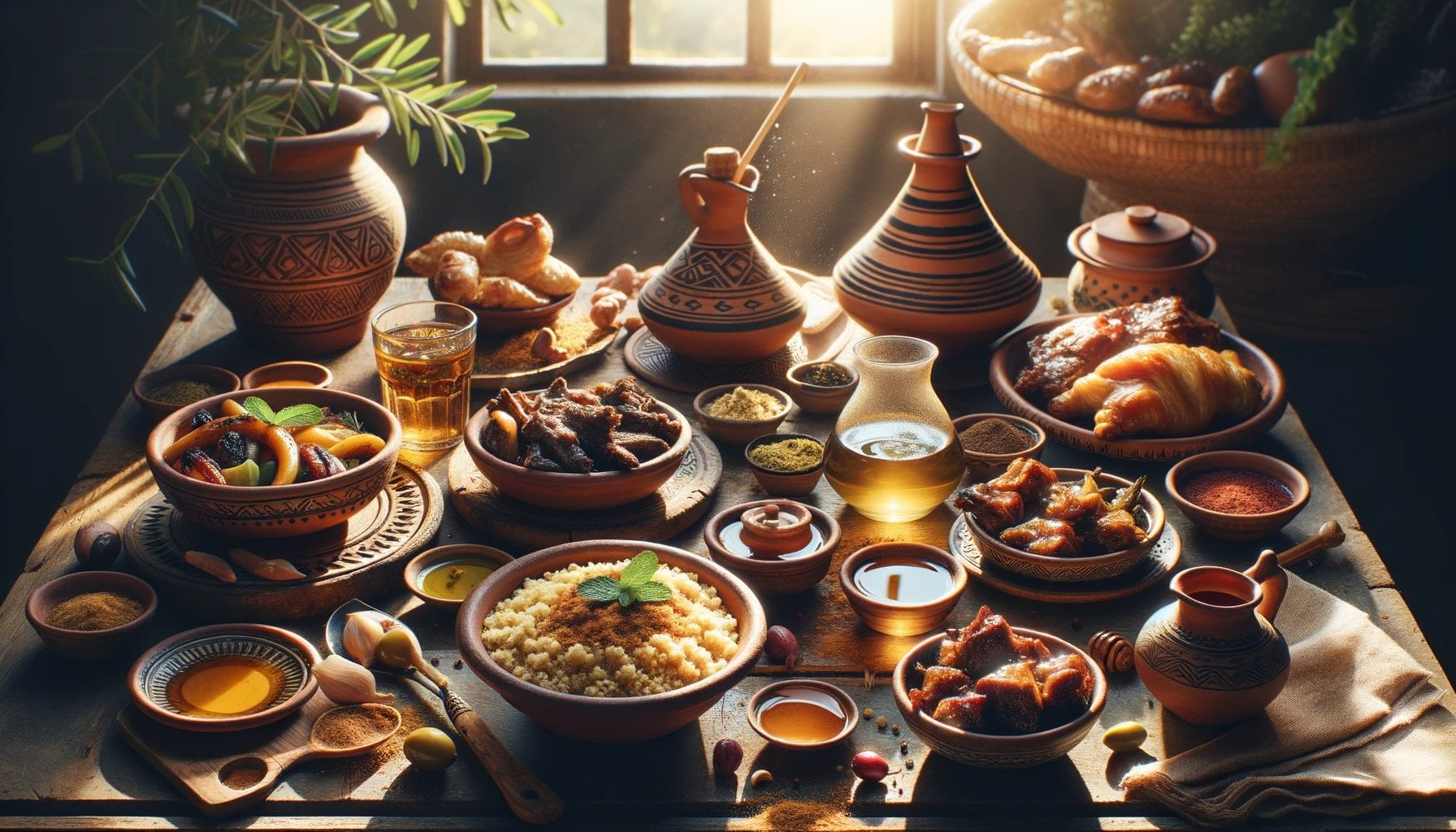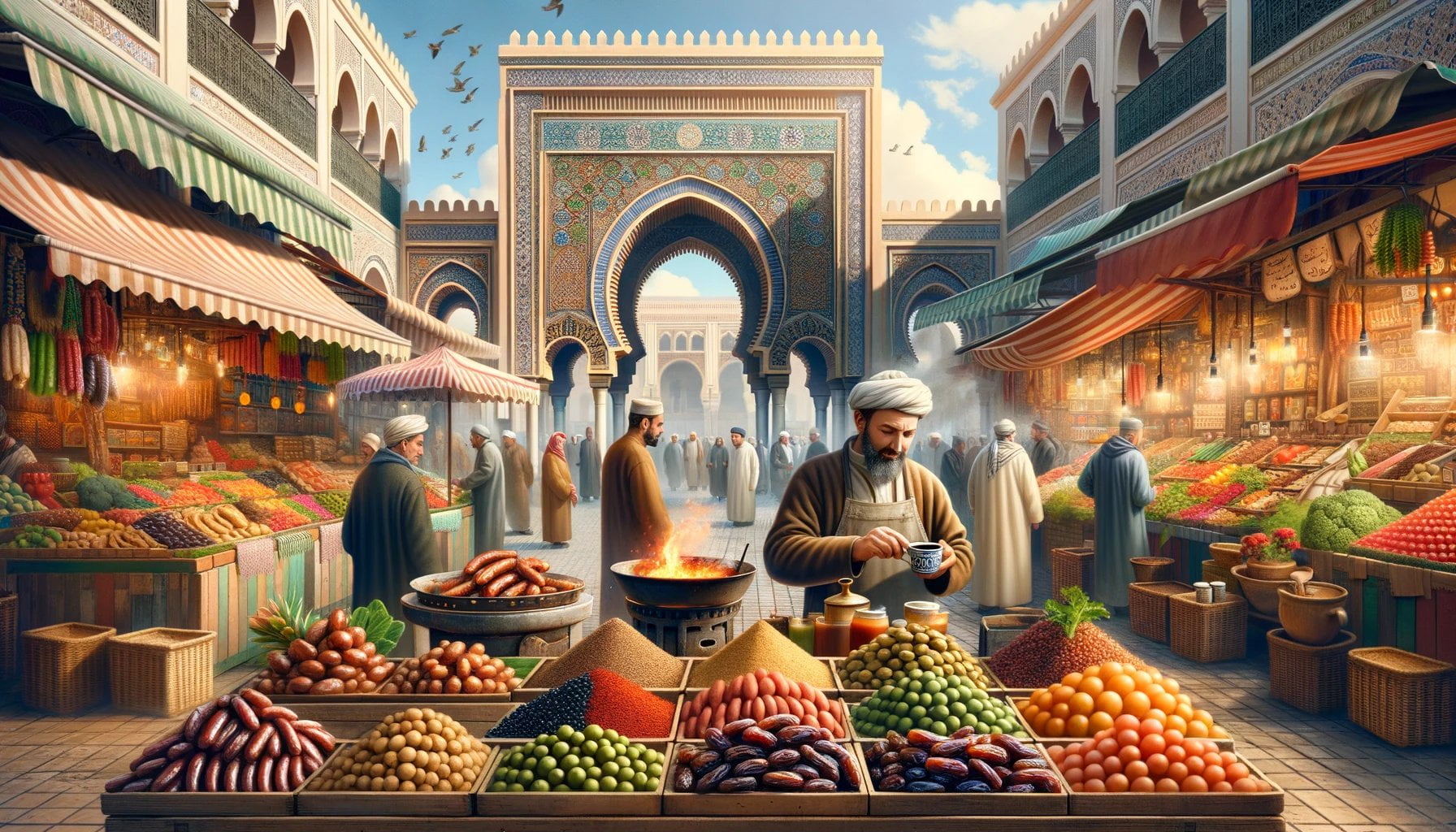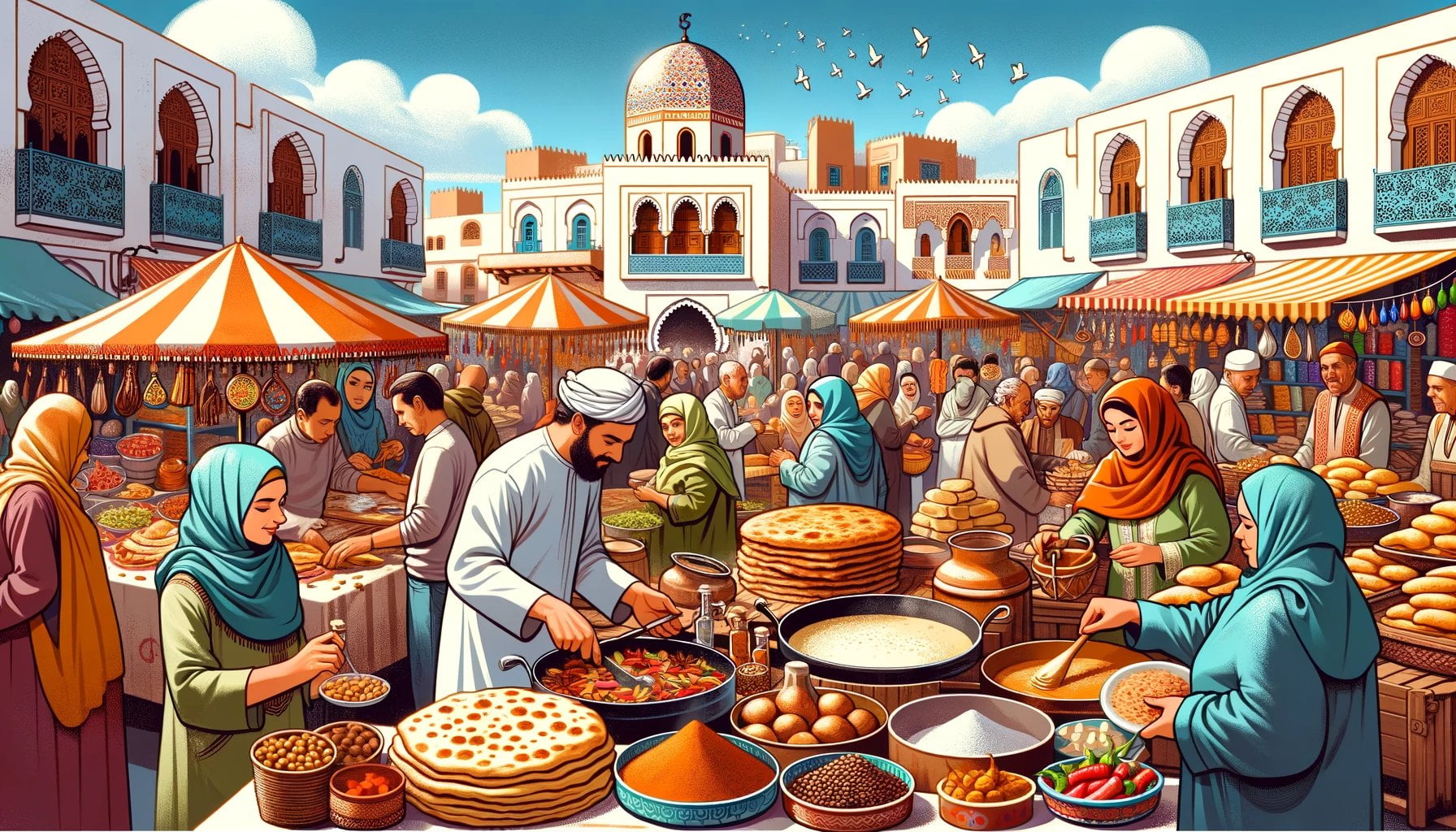Discover the vibrant flavors of Algerian cuisine as we embark on a sensory journey through the rich tapestry of this North African culinary tradition. With its unique blend of Mediterranean influences, North African spices, and French culinary techniques, Algerian cuisine offers a tantalizing array of flavors and dishes that will captivate your taste buds. From the fragrant aroma of couscous to the aromatic spices used in traditional tajines, and the delicate sweetness of Algerian pastries, each bite tells a story rooted in history and culture. Join us as we delve into the depths of Algerian gastronomy, uncovering the secrets of its traditional dishes and offering insights and recipe suggestions to bring these flavors into your own kitchen.

Key Takeaways:
- Algerian cuisine is a fusion of rich flavors influenced by the country’s interactions with various cultures and nations over the centuries.
- Vegetables and cereals play a prominent role in Algerian cuisine, with a wide variety of vegetables used in various dishes.
- Meat, particularly lamb, is a staple protein source in Algerian cuisine, and meat is found in almost every dish.
- Algeria’s coastal location allows for a variety of seafood and fish options in their cuisine.
- Algerian cuisine incorporates a skillful use of spices and herbs, adding vibrant flavors to their dishes.
- Meals in Algerian cuisine often start with smaller starters and appetizers, such as soups and traditional salads.
- Couscous is a famous and treasured dish in Algerian cuisine, often accompanied by vegetables, meats, and flavorful sauces.
- Algerian cuisine reflects a fusion of flavors and ingredients influenced by Berbers, Arabs, Turks, Andalusians, French, and Spaniards.
- Exploring Algerian cuisine offers a culinary journey through the rich history and diverse cultural heritage of the country.
Algeria Cuisine
Algerian cuisine is a treasure trove of vibrant flavors and cultural exchanges. Influenced by its Mediterranean and North African roots, it showcases a wealth of ingredients derived from both land and sea. From vegetables and cereals to meats and spices, Algerian cuisine offers a diverse range of dishes that vary by region and season.
A Fusion of Flavors
One of the defining features of Algerian cuisine is the prominent use of vegetables and cereals. Algerians possess impressive culinary skills in combining these ingredients with others to create flavorful and nutritious meals. Vegetables like potatoes, carrots, onions, tomatoes, and zucchini are commonly used, along with a variety of flavorful herbs and spices. The vibrant flavors in Algerian cuisine are enhanced by the skillful use of spices and herbs such as dried red chili, turmeric, ginger, paprika, and coriander. Traditional Algerian spice mixes like ras el hanout and Hror add depth and complexity to their recipes.
The Meaty Delights
Meat, particularly lamb, is a staple protein source in Algerian cuisine. It can be found in almost every dish, showcasing the Algerians’ love for meat. Poultry, beef, game meats like birds and venison, and even dromedary (camel meat) are also commonly enjoyed. The merguez, a type of sausage originating from the Berber people, is a popular meat product in Algeria.
Coastal Influences
Algeria’s geographic location along the Mediterranean Sea allows for an abundance of seafood and fish options in their cuisine. Sardines, shrimp, octopus, and various fish varieties like hake, tuna, and cod are used in stews or fried dishes. This coastal influence adds a unique touch to the Algerian culinary repertoire.
A Symphony of Flavors in Every Dish
Algerian meals often begin with a variety of smaller starters and appetizers to whet the appetite. Delicious soups like the famous chorba are commonly served before the main course. Traditional salads featuring a combination of vegetables like beet, corn, cucumber, and tomato provide a refreshing start to a meal. These starters are a testament to the Algerians’ attention to detail and their passion for creating a sensory feast.
The Pride of Algerian Cuisine: Couscous
When it comes to Algerian cuisine, couscous undoubtedly takes center stage. Considered a national culinary treasure, it is a traditional staple made from semolina. Couscous is often accompanied by a variety of vegetables, meats, and flavorful sauces, creating a delightful feast of textures and tastes. Its versatility allows for endless possibilities, making it a favorite among both locals and visitors.
Cultural Fusion on a Plate
Algerian cuisine beautifully showcases the profound cultural exchanges that have shaped its gastronomy over time. The country’s interactions with Berbers, Arabs, Turks, Andalusians, French, and Spaniards have contributed to the unique fusion of flavors and ingredients found in Algerian dishes. Each region has its own specialties and seasonal variations, offering a culinary journey through the rich history and diverse cultural heritage of the country.
For further reading on Algerian cuisine, you can visit the following sources:
1. Wikipedia. “Algerian cuisine.” Visit Website
So why not embark on a flavorful adventure and discover the tantalizing flavors of Algerian cuisine today?
Here are some fascinating facts about Algeria that you may not know. Discover more about the country’s history, culture, tourism, and famous places in Algeria.
Click on the links above to explore each topic in detail!
Traditional Algerian Dishes and Their Cultural Significance
Traditional Algerian dishes are not just about the flavors and ingredients; they also carry a rich cultural significance. These dishes showcase the country’s history, the fusion of culinary traditions, and the use of local ingredients. From the iconic Couscous to the flavorful Tajine Zitoun, each dish tells a story of Algeria’s diverse heritage.
Couscous: A Symbol of Community and Generosity
Couscous, the quintessential Algerian dish, goes beyond being a flavorful meal. It holds a cultural significance that stems from centuries-old traditions. In the past, Algerians would offer couscous to the country’s poorest individuals, especially on Fridays, as an act of generosity and community bonding. Made from steamed semolina, couscous is accompanied by a hearty stew of meat and vegetables, creating a harmonious blend of flavors.
Tajine Zitoun: A Flavorful Ramadan Tradition
During the holy month of Ramadan, Tajine Zitoun takes center stage on Algerian tables. This popular dish features Kefta, seasoned meatballs made from minced beef, lamb, fish, or chicken. Cooked with olives, Tajine Zitoun embodies the rich flavors and aromatic spices of Algerian cuisine. It symbolizes the joy and togetherness of Ramadan, where families and communities come together to break their fast with this delightful dish.
Kesra: The Nourishing Bread of Algerian Culture
Kesra, a simple flatbread, plays a vital role in Algerian culinary traditions. Known by different names in different regions, such as Khobz Ftir near Algiers, Kesra is a staple in Algerian cuisine. Made using olive oil, this bread symbolizes nourishment and connection. It is often shared among family members, serving as a base for various Algerian dishes and evoking a sense of togetherness and unity.
Mhajeb: A Flavorful Fusion of Tunisian and Algerian Flavors
Mhajeb, an Algerian specialty, showcases the fusion of flavors and influences in Algerian cuisine. This tantalizing puff pastry, made with semolina, features a variety of fillings, commonly tomato and onion. Mhajeb demonstrates how Algerian culinary traditions have been influenced by neighboring countries while still maintaining their unique identity. It is loved for its delicious combination of flavors and textures, a testament to Algerian creativity in the kitchen.
Dolma: An Algerian Delight With an Ottoman Influence
Dolma, a traditional Algerian dish, traces its roots back to the Ottoman era. This dish involves stuffing various vegetables with minced meat and then cooking them to perfection. Dolma showcases the cultural exchanges between Algeria and the Ottoman Empire, infusing Algerian cuisine with layers of history and flavors. Whether prepared in white sauce or other variations, Dolma offers a rich and creamy experience that delights the senses.
These traditional Algerian dishes not only tantalize the taste buds but also provide a glimpse into the vibrant culture and history of the country. They represent the fusion of flavors, the influences from various regions and cultures, and the deep-rooted traditions that are preserved through generations. Exploring the traditional Algerian cuisine is like taking a journey through time, where each dish tells a story and celebrates the essence of Algerian culinary heritage.
Key Takeaways:
- Traditional Algerian dishes hold cultural significance and reflect the country’s history and diverse culinary traditions.
- Couscous, a symbol of generosity, is served with a flavorful stew of meat and vegetables.
- Tajine Zitoun, popular during Ramadan, features seasoned meatballs cooked with olives.
- Kesra, a simple olive oil flatbread, symbolizes nourishment and togetherness.
- Mhajeb showcases the fusion of flavors, influenced by Tunisian cuisine, and is loved for its delicious fillings.
- Dolma, with its Ottoman roots, involves stuffing various vegetables with minced meat, adding rich and creamy flavors to Algerian cuisine.
Sources:
– Nomad Paradise: Algerian Food
– Wikipedia: Algerian Cuisine
Influence of French cuisine on Algerian culinary traditions
Key Takeaways:
- Algerian cuisine has been heavily influenced by French culinary traditions due to the country’s history of colonization.
- French cooking techniques and ingredients have been incorporated into Algerian dishes, resulting in a unique fusion of flavors.
- The use of French sauces, pastries, and desserts is prevalent in Algerian cuisine, adding a touch of decadence to traditional dishes.
A Fusion of Flavors: How French Cuisine Shaped Algerian Culinary Traditions
When exploring the vibrant flavors of Algerian cuisine, it becomes evident that the influence of French culinary traditions is an integral part of the country’s gastronomic heritage. The historical interactions between Algeria and France have paved the way for a fusion of flavors and cooking techniques that tantalize the taste buds and embody a cultural exchange.
The Colonial Connection
During the colonial era, Algeria was under French rule, and this period of colonization left an indelible mark on the country’s culinary traditions. French settlers brought with them their expertise in cooking, introducing new ingredients, techniques, and flavors that became integrated with Algerian cuisine.
A Melting Pot of Ingredients
One of the most noticeable impacts of French cuisine on Algerian culinary traditions is the assortment of ingredients that have become staples in Algerian dishes. The French introduced a wide variety of vegetables, herbs, and spices, which added depth and complexity to Algerian recipes. Staples such as potatoes, carrots, onions, and garlic became essential elements in Algerian cooking, enhancing the flavors of traditional dishes.
Sauces, Pastries, and Desserts
The French are renowned for their culinary prowess when it comes to sauces, pastries, and desserts, and these elements have found their way into Algerian cuisine. French sauces, such as béarnaise and hollandaise, are often used in Algerian dishes to add richness and depth of flavor. The incorporation of French pastries and desserts, such as croissants and crème brûlée, also adds a touch of indulgence to Algerian culinary offerings.
A Harmonious Fusion
The fusion of French and Algerian culinary traditions creates a harmonious blend of flavors and techniques that is distinctively Algerian. This seamless integration allows for a diverse range of dishes that celebrate the diversity of cultural influences. From hearty stews to delicate pastries, Algerian cuisine showcases the perfect marriage between French finesse and North African vibrancy.
Embracing Cultural Exchange
The influence of French cuisine on Algerian culinary traditions serves as a testament to the power of cultural exchange. It is a reflection of Algeria’s complex history and its ability to embrace foreign influences while retaining its unique identity. Algerian cuisine not only delights the senses but also tells a story of a nation that has evolved and thrived through its interactions with the world.
In conclusion, the influence of French cuisine on Algerian culinary traditions is undeniable. From ingredients to techniques, the fusion of flavors showcases Algeria’s rich history and cultural diversity. The incorporation of French sauces, pastries, and desserts adds a touch of elegance and decadence to traditional Algerian dishes, creating a gastronomic experience that is truly unique.
SOURCES:
Exploring Algerian Pastries and Desserts
Algerian desserts are a true delight, filled with exotic flavors and the perfect balance of sweetness. They are a testament to the nation’s rich culinary heritage and are often enjoyed during important celebrations and special occasions. In this article, we will delve into the world of Algerian pastries and desserts, exploring the tantalizing treats that are beloved in Algerian cuisine.
Makroud el Louz: Let’s start with a unique Algerian cookie that stands out for being made without flour. Makroud el Louz is a popular dessert made with semolina, honey, and nuts. It has a delightful crunchy texture and a sweet fragrance that will transport you to the vibrant streets of Algeria.
Griwech: Another gem in Algerian pastry tradition is Griwech, a delicate and beautifully twisted pastry. It is made with a special dough that is flavored with orange blossom water and deep-fried to perfection. Griwech is known for its intricate design and is often enjoyed with a cup of aromatic tea.
Kalb el Louz: Get ready to indulge in the heart of almond with Kalb el Louz, a traditional Algerian dessert. This sweet treat is made with semolina, almonds, and a fragrant orange blossom syrup. The tender slices of Kalb el Louz are not only visually stunning but also offer a burst of nutty and floral flavors.
Baklava: Widely adored in Algeria, Baklava is a delicacy that needs no introduction. Layers of thin filo pastry are filled with a mixture of nuts, such as pistachios and almonds, and soaked in a sweet syrup. The result is an amazingly delicious treat that combines crunchy layers with a heavenly sweetness.
Tcharek Msaker: Known as “masked face,” Tcharek Msaker is a cherished Algerian dessert. It features a delicate pastry filled with an almond paste mixture and beautifully shaped to resemble a masked face. The combination of the buttery pastry and the rich almond filling creates a delightful harmony of flavors.
Other Popular Algerian Desserts: Algeria has an array of desserts to satisfy every sweet tooth. From Mbesses, which are semolina cakes soaked in honey or syrup, to Tamin, a sweet porridge dish made with dates and milk, Algerian desserts showcase a diverse range of flavors and textures. Mkhabez, Boussou la Tmessou, and Baghrir are also among the delicious treats that will take your taste buds on an adventure.
Algerian pastries and desserts are not only a treat for the palate but also a feast for the eyes. They are known for their intricate designs, bright colors, and the skillful artistry that goes into their creation. Each dessert tells a story, reflecting the cultural diversity and rich history of Algeria.
Key Takeaways:
– Makroud el Louz is a popular Algerian cookie made without flour, featuring semolina, honey, and nuts.
– Griwech is a delicate and beautifully twisted pastry flavored with orange blossom water.
– Kalb el Louz is a traditional Algerian dessert made with semolina, almonds, and a fragrant syrup.
– Baklava is widely adored in Algeria and combines layers of filo pastry with a sweet nut filling.
– Tcharek Msaker, or “masked face,” is a cherished Algerian dessert with a buttery pastry and rich almond filling.
– Algeria offers a variety of desserts, including Mbesses, Tamin, Mkhabez, Boussou la Tmessou, and Baghrir.
– Algerian desserts are known for their intricate designs, bright colors, and the skillful artistry that goes into their creation.
Sources:
1. Chef’s Pencil: Top 25 Algerian Desserts
2. TasteAtlas: 8 Most Popular Algerian Desserts

FAQ
Q1: What are the key influences on Algerian cuisine?
A1: Algerian cuisine is influenced by interactions with various cultures and nations over the centuries, including Arab, Berber, and French culinary traditions.
Q2: What are some traditional Algerian dishes?
A2: Some traditional Algerian dishes include couscous, tajine zitoun, kesra (a type of flatbread), mhajeb (puff pastry), and dolma (stuffed vegetables).
Q3: What are the main ingredients used in Algerian cuisine?
A3: Algerian cuisine incorporates a variety of ingredients, such as lamb, poultry, beef, game, seafood, fish, vegetables (including potatoes, carrots, onions, tomatoes, and more), spices (such as chili, cumin, cinnamon, ginger, and more), and herbs.
Q4: What are some popular Algerian desserts?
A4: Algerian desserts are known for their sweet treats made with ingredients like honey, nuts, semolina, and flour. Some popular Algerian desserts include makroud el louz, griwech, kalb el louz, baklava, tcharek msaker, mbesses, tamin, mkhabez, boussou la tmessou, and baghrir.
Q5: How does Algerian cuisine reflect the country’s history and cultural diversity?
A5: Algerian cuisine reflects the country’s rich history and cultural diversity through its fusion of flavors, ingredients, and culinary traditions influenced by various cultures and nations. From regional variations to seasonal specialties, Algerian cuisine offers a culinary journey through the diverse cultural heritage of the country.















